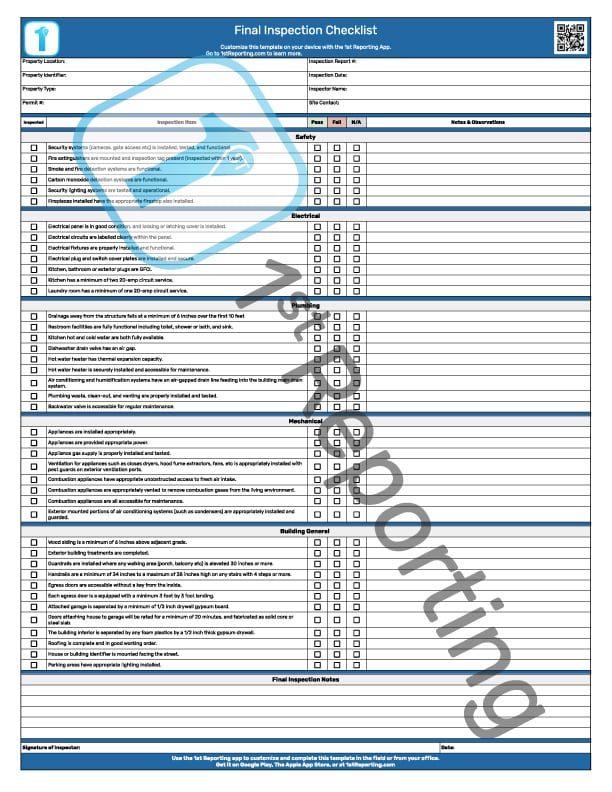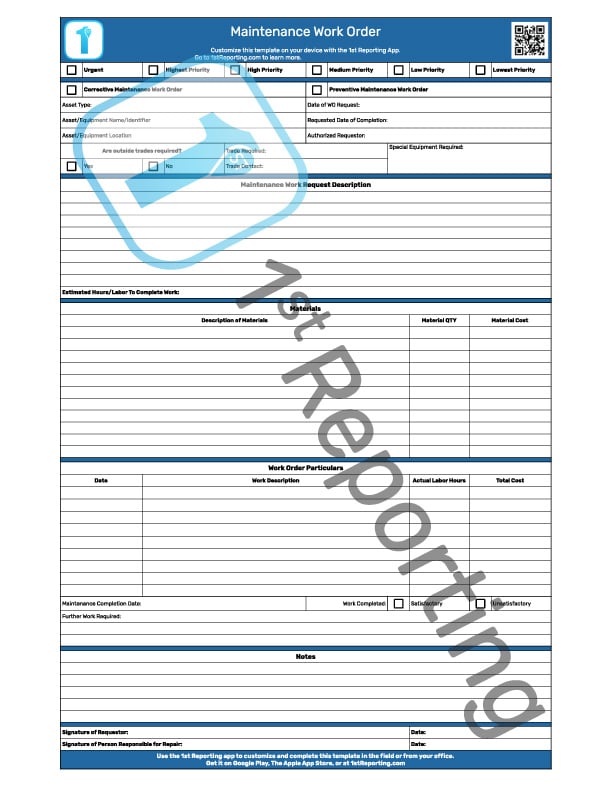A residential final inspection checklist is vital for maintaining an organized and efficient final inspection workflow. It’s also imperative that each item is documented accordingly, and the residential final inspection checklist for professionals is the perfect tool for the job.
A residential final inspection checklist is a document containing the results of a property’s final inspection before a Certificate of Occupancy (CO) is issued. Professionals who perform repairs, maintenance, renovations, or building fabrication should all utilize the checklist to ensure their workmanship is up to specifications.
Finding a mediocre checklist is easy, but finding a great one that is easy to use and follow for your team can be challenging. Luckily, you’ve found your prize: The downloadable Residential Final Inspection Checklist.
Included In The Residential Final Inspection Checklist For Professionals
For your convenience, the checklist consists of seven sections. Each section corresponds to an area of focus for the inspection, acting as a final inspection guide. The following sections are the sections you’ll find on the template.
- Administrative section – This is where you’ll find a place to record information about the property, provide a number to identify the inspection and include the inspection date and inspector name.
Following the administrative section, we have a column heading row that shows each column’s intent and a conveniently color-coded checkbox area. Each row includes a primary checkbox in the column entitled “Inspected”. The goal is to use the checklist as a primer to help streamline the process. The template becomes an instruction manual for inspectors to follow on final inspections by providing checkpoints.
- Safety section – The first primary section for recording inspection observations is the safety section. Named, we felt this section of a final residential inspection should come first, given it’s essential for protecting life and limb.
- Electrical section – This section covers many serious electrical points that we thought needed inclusion near the top of the inspection report.
- Plumbing section – Plumbing is essential to any live-in facility, home, rental apartment, or other dwellings.
- Mechanical section – Covering topics including appliance venting and access, the mechanical section focuses on items like the furnace, clothes dryer, and other large appliances.
- Building – General section -Approaching the end of the template, the last checkpoint section has the various general inspection points of the residential structure that are not yet covered.
- Notes and Sign-Off Section – The final section of the residential final inspection checklist provides an area for the inspector to add further comments and sign off on the inspection as completed.
How To Use A Final Inspection Checklist
Using the checklist we’ve created is easy. You must download the template, print as many copies as you need, and ensure your team knows how to complete the checklist.
You will also need to develop a system to file and organize your inspection information. Most people focus on obtaining their checklists without considering how they will manage the process or organization after completion.
We have an excellent system for mastering your inspection management and solving the pesky issue of hunting down a decent checklist or template. We’ve got a whole library of templates you’re likely to use daily at your business. Read on to find out more.
Tips For Faster And More Efficient Inspections
We promised tips, and we’re about to deliver. Here are a few handy tips and tricks to help you manage your time more efficiently when managing your inspections. After all, you’ve got many other things to consider without worrying about taking too long to find inspection notes from a previous review.
Pre-Plan Inspections
This may seem common sense, but you would be surprised how many people don’t do this. By pre-planning your inspection, you can develop a system to become more efficient and save time. Creating a plan will help you focus on what needs completion during each inspection. The plan should include:
- Determining who will conduct the inspection
- What type of inspection is required
- When the assessment should take place
Creating a plan for each inspection will help you focus on what needs to be accomplished and eliminate distractions that can waste time.
Define the specific goals you want to achieve with field reporting and inspections. Doing this during the pre-planning stages of your assessment is incredibly crucial. You can obtain the best course of action to achieve the desired result.
Develop A Streamlining Work Culture
Streamline data collection and reporting processes to make them more efficient. Implementing and sharing this concept in your meetings with staff will help foster their positive attitude toward innovation. Innovating your reporting and inspection documentation process for residential and commercial properties is critical to increasing your organization’s overall profitability.
Monitor Progress With Checklists And Templates
As we’ve already discussed, checklists and templates are essential for managing inspections. Not only do they help you keep track of what needs completion, but they also help you monitor your progress.
A master checklist or template lets you quickly see where you are in the inspection process and what still needs completion. It will help you stay on track and avoid missing anything essential.
Review Previous Documents and Processes
Periodically review field reporting processes to ensure they are still effective and efficient. It’s far better to take a few moments to improve an older process than to continue wasting time and effort on a broken process.
Take Time To Train
Train staff on how to use new tools and systems effectively. Merely introducing tools and expecting your team to figure them out is a bit of a gamble. It’s much more effective and less of a liability to take the time to properly train staff and ensure their understanding of tools implemented to improve the process.
Implement Inspection Key Indicators and Tracking
Implementing measurables to determine the completeness or efficiency of inspections is crucial. Tracking multiple inspection completions will allow you to track trends in inspection processes that can help you improve the management of those processes.
Although paper reports are excellent for recording written data, they can be challenging to keep track of and manage. That’s one of the many reasons we have created the 1st Reporting app. Let’s discuss the technology that will help you manage your inspection processes.
Manage Your Time With Technology
Technology can help you manage your time more efficiently when conducting inspections. Many software applications can help you schedule inspections, create checklists, and store inspection information. However, only one has all the features you need to operate your business and increase process efficiency: 1st Reporting.
Technology will help you save time by automating repetitive tasks and keeping all your inspection information in one place. It will allow you to focus on other aspects of your business and avoid wasting time searching for lost paperwork.
Similarly, utilizing technology like that provided in the 1st Reporting app can aid your team by allowing you to create dynamic workflows with checklists that change based on user input.
This sort of technology is beneficial for:
- Controlling process flow, steps, and stages
- Training new team members on complicated company processes
- Guiding inspectors through complex inspections
- Providing a means for inspectors to include information that could alter the course of the inspection and allow the assessment to adapt accordingly.
These are just a taste of the features that make the 1st Reporting app your complete process, inspection, and service field reporting solution. It gives you the tools you need at your fingertips to manage inspections efficiently and effectively.
Summary
This article discusses the importance of innovation in property inspection and reporting and how technology can help manage time and improve efficiency. We’ve provided a downloadable checklist your organization can use for final residential inspections and an overview of the template.
We mention that the 1st Reporting app has all the features needed to manage inspections and provide examples of how you can use the app to streamline processes. Similarly, it’s a powerful inspection management tool that allows you to generate reports to track inspection processes and results trends.





